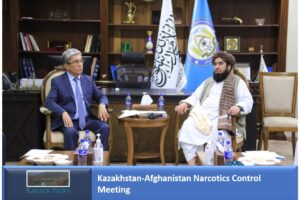By Kauser News Agency, USA

October 25, 2024 – Kabul, Afghanistan
In a rapidly shifting power landscape within Afghanistan, Sarajuddin Haqqani, a high-ranking Taliban leader and influential figure within the Haqqani network, is reportedly positioning himself to replace Taliban Supreme Leader Haibatullah Akhundzada. Haqqani has expanded his reach, consolidating power in remote areas across Afghanistan while pressuring the Kandahar faction, led by Haibatullah, to cede control. This internal rift signals a potential realignment of power within the Taliban as Haqqani’s influence grows, underscored by his alleged connections with foreign intelligence agencies—a development that suggests he has international support behind him.
The Haqqani network, traditionally more militant and deeply rooted in eastern Afghanistan, has strengthened its hold over critical regions, bolstering its security measures and expanding its influence beyond the capital of Kabul. By taking control of these strategic areas, Haqqani’s forces have forced the Kandahar-based faction into a defensive position, threatening the influence of Haibatullah Akhundzada and his close associates.
Haqqani’s growing network of foreign connections has raised suspicions and concerns about potential interference from external agencies, who may see his leadership as more amenable to their interests in the region. If he ascends to the leadership, Haqqani could shift the Taliban’s policies, further distancing himself from the hardline traditions associated with Haibatullah’s Kandahar faction. However, such a move risks deepening internal divisions within the Taliban, potentially destabilizing its leadership.
Rising Domestic Resistance
While internal tensions escalate within the Taliban, resistance to the regime is also on the rise from various groups across Afghanistan. ANDSF Forces ALM Pamir Ghorzang, AFF General Zia, and the National Resistance Front (NRF) have increased the frequency of their attacks against Taliban positions. Their goal is to challenge Taliban authority and rally support among Afghans dissatisfied with Taliban rule. These groups, operating in various regions, aim to weaken the Taliban by targeting their supply routes, disrupting communications, and mounting surprise attacks on Taliban forces.
These armed resistance efforts, while varied in strategy and resources, highlight the challenges the Taliban faces in maintaining its grip on power. The groups draw support from communities affected by Taliban policies and governance, which they criticize as overly restrictive and out of touch with the Afghan population’s needs. If the internal rift within the Taliban continues to grow, these resistance forces may gain further momentum, leveraging any signs of disunity in Kabul.
U.S. Presidential Campaign and Implications for Afghanistan
Meanwhile, developments in the United States could also shape Afghanistan’s future. The U.S. presidential campaign is underway, and former President Donald Trump, a prominent candidate, has vowed to reconsider the current administration’s approach to Afghanistan. Trump has consistently criticized the U.S. withdrawal from Bagram Air Base, indicating his opposition to leaving the strategic site to potential adversaries, including China. Trump has hinted that, if elected, he might support a return of U.S. forces to Bagram—a move that would represent a significant shift in U.S. foreign policy.
Such a scenario would place pressure on the Taliban, which remains largely unrecognized internationally and is grappling with internal resistance and limited resources. A potential return of U.S. forces to Afghanistan could embolden opposition groups within the country, weaken the Taliban’s already precarious position, and potentially mark the beginning of the end for its regime. Additionally, renewed U.S. involvement might curtail foreign support for the Taliban from nations wary of a prolonged conflict.
The Road Ahead
The situation in Afghanistan is fluid and fraught with complexity. The Haqqani network’s growing control within the Taliban, coupled with the rise of domestic resistance forces and potential shifts in U.S. policy, create an uncertain future for the country. If Sarajuddin Haqqani succeeds in consolidating his power and displacing Haibatullah Akhundzada, the Taliban’s internal policies and regional alliances could shift dramatically, altering Afghanistan’s path forward.
With multiple forces now vying for influence, the next few months will be critical in determining Afghanistan’s stability. As these power struggles unfold, the world watches closely, aware that any significant shifts could have lasting impacts not only for Afghanistan but for broader regional security.




